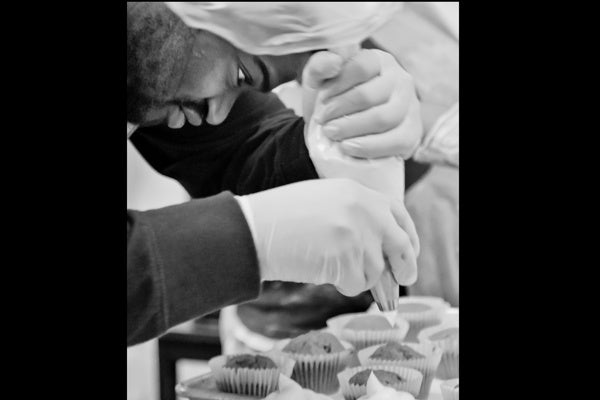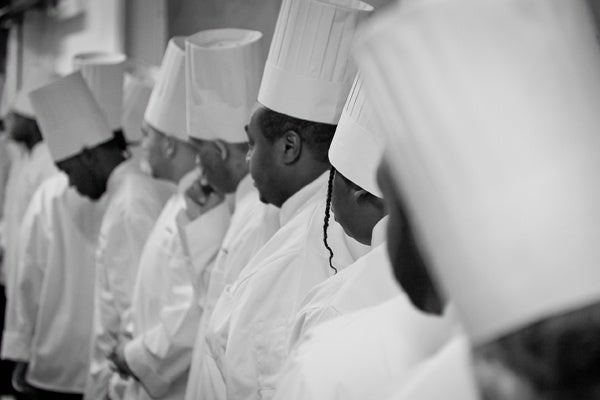Princeton’s Woodrow Wilson School exhibits ‘Cooking for Change’
This is part of a series from Ilene Dube of The Artful Blogger.
A group of people gathered around a table eating constitutes at least one definition of family. Whether the meal has been created by a grandmother in the kitchen or brought from a nearby Chinese restaurant, there is always a cook at the heart of it.
The past decade has seen jobs outsourced to other countries, jobs lost to downsizing of companies and entire industries, and jobs replaced by machines.
The job of cook can’t be outsourced, and for the time being, a machine can’t do it. School cafeterias, hospital kitchens, the prepared food section of the supermarket, restaurants and retirement communities all need cooks.
The food industry offers opportunities for ex-offenders, recovering addicts and those who have been out of the labor market for a period of time. In Hillside, on the outskirts of Newark, the Food Service Training Academy of the Community FoodBank of New Jersey offers a free, 14-week training program to the economically disadvantaged.
The success of the program is documented on the faces of the program’s participants in Cooking for Change, a series of photographs by Steve Riskind with text by Doris Friedensohn, professor emerita of women’s studies, New Jersey City University. On view at the Bernstein Gallery, Woodrow Wilson School, Princeton University, through June 7, the exhibit grew out of the book Cooking for Change: Tales from a Food Serve Training Academy (Full Court Press, 2011).
“Cooking for Change reminds viewers that becoming a proficient cook is no easy business,” said Curator Kate Somers. “The photographs and text provide a window into the exhilaration and hope, and the frustrations and challenges facing students at the Food Service Training Academy.”
The food business is no place for slackers – it is a demanding and unforgiving business, the students are taught. There are long hours and few breaks from the sweltering kitchens, where scars from hot oil are not uncommon. Pay is rarely more than $10 to $15 an hour. Students can dream of moving from salad maker or breakfast cook to sous chef or, the ultimate, owning a restaurant.
The training bestows a sense of self worth on participants: to be able to put together raw ingredients and create something that will please and nourish others. One student is focused on squeezing frosting from a pastry tube on to banana pudding cupcakes, his specialty. He hopes to open a cupcake business with his brother.
In another image, a man in a hairnet, beard net and white apron looks admiringly at Chef Portia, a volunteer who teaches a baking class five days a week and makes herself available, via cell phone, to the 200 graduates who may need her advice. Here, she holds up a spoon, as if making a point to her mentee, imparting her high standards.
Anyone who has had a few friends over to dinner knows the challenge of getting everything out of the oven at the same time. Multiply that for the volume served in a professional kitchen, where there’s no room for mistakes.
With pastries, pies, cookies and tarts, presentation is essential. Students hone dexterity, concentration and attention to detail. If they succeed, they will get jobs through the school’s culinary employment specialist. Bruce Tyndell, who managed a luxury carpet warehouse before the Great Recession, was “a savvy home cook,” and found his way to FSTA, where he was the first in his graduating class to be hired. Casey Cabreja, a former model and dental assistant, was selected for a 16-week paid apprenticeship assisting the chefs.
FSTA is housed in the Community FoodBank’s 7.5 acre warehouse, and at the center is a large teaching kitchen, where students are responsible for preparing hot lunches for the food bank’s staff. They also help to cook and freeze the thousands of meals distributed to New Jersey families in need each week.
Cooking for Change: Photographs by Steve Riskind and text by Doris Friedensohn is on view at the Bernstein Gallery, Woodrow Wilson School, Princeton University, through June 7. Hours: M-F, 8:30 – 5:30 p.m. princeton.edu/bernstein
______________________________________________________
The Artful Blogger is written by Ilene Dube and offers a look inside the art world of the greater Princeton area. Ilene Dube is an award-winning arts writer and editor, as well as an artist, curator and activist for the arts.
WHYY is your source for fact-based, in-depth journalism and information. As a nonprofit organization, we rely on financial support from readers like you. Please give today.










